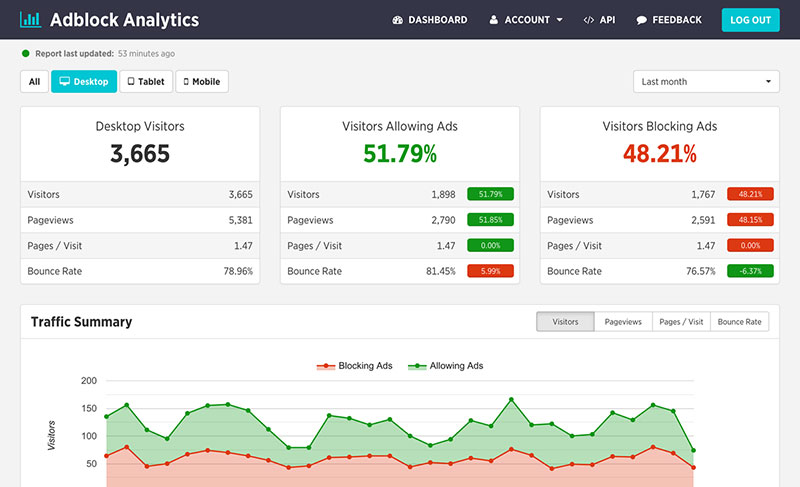How Do Websites Detect Adblock? It’s Quite Simple, Actually

As daylight recedes, the silhouette of an astute web traveler emerges, navigating the digital expanse. Reminiscent of an invisible dance, how websites detect AdBlock pirouettes into the spotlight—an intricately choreographed number between consumer choice and the sustenance of cyberspace stewards.
In this modern-day imbroglio, what ensues is an arms race, pitting browser extensions against ingenious JavaScript detection scripts.
Herein lies an odyssey of content blocker detection, a testament to the perpetual oscillation of online advertising impact. The stakes? A robust digital advertising strategy—the lifeblood of the creative minds behind every pixel in your viewport.
Dive deep into this confluence of webpage script for detecting blockers and advertising campaign fortitude, wherefore by article’s close, emerge enlightened on the artistry behind hidden digital barricades. This exploration promises a resolution—not merely a list of methods but the cogs and gears propelling Ad-blocking countermeasures into motion.
In the tableau vivant to follow, categories unravel: Anti-AdBlock strategies, advertising network response, and content monetization—each a chapter in an epic where privacy, preference, and pecuniary necessity coalesce.
How does Adblock detection work?

The purpose of an ad blocker is to block advertisements when navigating web pages. They are browser extensions or plugins.
They filter different server addresses analyzing their patterns. They block communication with ad servers and hide site elements that display ads.
Some browsers block ads by default and users can add extra blocking filters. This is the case with Google Chrome.
The ad-blocking process starts as soon as the web page begins to load on the server. An ad blocker scans the website’s scripts and compares them to a database.
If it finds scripts that match those in the database, the software prevents them from loading. It works with a database of ad-related scripts and can understand where the annoying ads are.
The next step is to block them. The user will see a blank space instead of the ad design.
Why use an ad blocker?
Users install this software for a variety of reasons. They may have concerns about tracking processes and want to keep their information private, especially when running the WordPress membership plugin and sharing unique ideas, exchanging sensitive data, etc.
In other cases, they want to avoid tiresome advertisements. Sometimes, they simply want a larger bandwidth.
There are some very popular ad-blocking software on the market. These include uBlock, Brave, AdBlock, and AdBlock plus.
Adblock detection: how to detect ad-blocking

There are methods to prevent advertisement blocking. Companies like Forbes and Business Insider use anti-Adblock methods.
This software works by analyzing a website and its scripts. Thus, it forms a previous image of what the web page will be like when loaded.
Once loaded, the software compares the expected page with the rendered version. If these don’t match, the website sends an anti-ad-blocking message.
The software throws a code that works as a ‘bait’ for ad blockers. This is a piece of code that appears to have advertising elements.
It is generally a hidden div. It contains a file, like ‘ads.js’, that’s usually the target of adblockers.
When the ad blocker ‘bites’ the bait, the system releases an ad blocker message alert. How does this work?
When a browser extension tries to block the “ad”, the bait modifies the rendering version of the site. This can help identify the presence of a plugin or extension blocking ads.
The ad-blocking tactics are usually shared across the web. This information can also be useful for creating baits.
The following is an example of a ‘bait’ code:
<divclass="banner_ad">...</div>.
By reading ‘banner_ad’ in the code, the browser will release an ad blocker. Many ad-blocking lists carry this text.
These lists include references to JavaScript files and CSS stylesheets.
Ad blockers compare a site’s scripts with the ones from this list. When it finds a match, it prevents the script from loading.
Yet anti-ad blocker software also uses this information to create baits. Anti ad-blocking works effectively and helps publishers mitigate their losses.
The first step is to detect where ad blockers are. After this, publishers can take different measures.
We can help you turn your idea into reality, take over your existing project, or extend your current development team.
Schedule a free consultation at hello@tms-outsource.com, or fill out the form and we will follow up with you shortly.
What measures to take after ad-block detection
- Ask for a voluntary donation to help create quality content.
- Ask users to white list the site or remove ad blocking for this page.
- Block access to the page’s content.
- Offer users a paid subscription free of ads.
- Offer an ad-free experience in exchange for social media engagement or email signup.
Anti-Ad-Blocking Scripts
Anti-Adblock technology has become a successful business. Many companies offer anti-ad-blocking codes, plugins, and apps.
However, it is still possible to find free options online. Next is a list of scripts that can be used to detect ad blockers.
Detectadblock

One of the easiest ways to detect an ad blocker is the use of ‘bait’. Sending a code that is similar to an ad-based script can reveal the anti-ad elements.
A piece of code that will trigger an ad alert is ‘ads.js’.
Detectadblock.com saves a piece of Javascript code and creates a hidden section (div) to a file called ‘ads.js’. It places this in the root directory o a user’s website.
Publishers insert the following piece of Javascript code into their HTML base:
<script src="/ads.js"
type="text/javascript"></script>
<script type="text/javascript"><br />
if(document.getElementById('RZfrHsidDwbG')){<br />
alert('Blocking Ads: No');<br />
} else {<br />
alert('Blocking Ads: Yes');<br />
}<br />
</script>
This code checks if there is a hidden ‘div’ in the targeted website, allowing ads to display. If there is not a ‘div’, this means that ads are blocked.
IAB Script
The Interactive Advertising Bureau aims to overcome the difficulties of today’s marketing. It consists of publishers and ad technology companies dedicated to research and development.
They have created the IAB ad-block detection script. This code has had successful testing on Chrome, Safari, Firefox, and Explorer.
Readers can access the IAB description and installation instructions here.
How to recover revenue losses caused by ad blockers?
While ad blocking is an excellent tool, it may not be the best option for every publisher.
Every advertiser needs to consider today’s diverse market and its constant innovations. Thus, it will be possible to choose the best suitable option.
Here are a few ways a publisher can recover revenue in a post-ad-blocker world.
Ad Reinsertion
This allows publishers to display acceptable ads on sites using an ad blocker.
This may be the least ethical of all the anti-ad-blocking strategies. It ignores the user’s desire to receive no advertisements.
Ad reinsertion technology requires marketing companies to be whitelisted by ad blocker creators. This requires constant updating on the publisher’s side and it brings little benefit.
After all, if the user is choosing to install an ad-blocker, they won’t be likely to click the reinserted ads.
Native Ads

Native ads are an excellent option for optimizing a marketing campaign. They are well blended with the site’s content, hence they are hard to detect using ad blockers.
An example of native ads are the sponsored posts a person can see on Facebook. They work so well that they are being used by news websites and online magazines.
Though hard to detect by ad blockers, they are not impossible to find and may still get blocked.
Engage
Engaging with ad-block users can be an excellent strategy. Publishers can offer many options.
They can try to find out what specific ads the user is not fond of and provide a solution.
If the user has an interest in the content, publishers can offer an ad-free paid subscription. They can also ask for the user to ‘whitelist’ them.
If users dislike a specific advertising format, publishers can offer a new website version. It can display a page with vetted ads or ads subject to certain guidelines.
Ad-free subscriptions
This is an excellent approach for news sites or bloggers. A website with lots of content can use advertisements to get subscribers.
Publishers and blog admins can offer an ad-free reading experience for a subscription.
For these websites, content is the main product. Hence, users are likely to pay a subscription to enjoy this content ad-free.
FAQs about how websites detect Adblock
How do sites recognize when an AdBlock is active?
Sites weave JavaScript detection scripts into their fabric, scouting for disruptions in ad delivery. Much like a game of cat and mouse, these scripts detect alterations in standard webpage behaviors synched with ad rendering, pointing to an AdBlock’s presence.
Can users conceal their use of AdBlock from detection?
Indeed, users often employ ad-blocking countermeasures or user scripts. These are akin to digital chameleons—evading detection and masquerading as non-blocker users. A stealthy drive towards anonymity, where browser extensions bend to the user’s will.
What prompts websites to scan for AdBlock?
The impetus? A tussle for survival. Publisher ad revenue hangs in the balance—ads unfurling as the lifeblood for much of the online ecosystem. Each ad blocker notification is a ripple in the pond of content monetization, a signal to safeguard revenue.
What happens if a website detects AdBlock?
A detection tips the first domino. Websites might extend an olive branch, urging whitelisting through a gentle Adblock detection message. Others erect barriers, restricting access, making alternative monetization models a topic of fervent discourse within the realms of digital marketing challenges.
Is AdBlock detection legal?
Absolutely. It stands within legal bounds—website code and server requests resonate with the rightful purview of content providers. They steward their domains, vigilant against encroaching forces that jeopardize ad industry’s response to an evolving internet landscape.
Do all ad blockers get detected by websites?
Not all. The dance is intricate, online ad blockers evolve perpetually, with new ad-blocking technology often sidestepping the watchful gaze of advertising script detection. A harmonious balance is rare; most often, it is a swinging pendulum.
How do AdBlock detectors affect user privacy?
Under the scanner, user behavior analytics receive a spotlight. Yet, concerns mount as user privacy teeters on a tightrope—sophisticated advertising network response mechanics may inadvertently entangle rather innocuous user data, stirring the pot of ethical advertising and confidentiality principles.
Can websites force you to disable AdBlock?
Force? No. Implore? Entirely. Through a blend of plea and persuasion, sites impel a user’s hand towards disabling ad-blocking software. Think of it as a stage where the script intones the narrative, and the visitor holds the power to turn the page.
Do AdBlock detectors impact website performance?
Detecting ad-blocking users may add an extra brush stroke to the canvas—minimal, yet perceivable. Web developer tools gauge performance, ensuring these detection scripts add but a feather’s weight to web browsing experience precision.
Are there any alternatives to using AdBlock detectors for websites?
Whitelist advertising rises as an alternative, painting publisher’s rights beside an inviting image. Partnerships, subscription-based models, and donation buttons don vibrant colors, sketching a less confrontational route through the mire of website monetization strategies.
Can adblocker detection be bypassed or disabled?
Yes, there are ways to get around adblocker detection on websites, such as employing anti-adblocker extensions or browser plugins, changing the user-agent string in the browser, or utilizing a proxy or VPN service. Certain websites, however, may use defense mechanisms to identify and prevent such bypass techniques.
What are some ways to prevent adblocker detection on websites?
By employing anti-adblocker extensions or browser plugins, changing the user-agent string in their browser, or by using a proxy or VPN service, users can avoid being detected as using an adblocker. However, it is crucial to note that some websites may deploy countermeasures to detect and stop such bypass methods. Also, privacy laws are getting stricter and many users install ad blockers. Many users, concerned about their online privacy, opt for solutions like ExpressVPN to secure their internet connection.
Conclusion
The tapestry of the web is interwoven with threads of innovation and website code mastery. In pursuit of harmonizing the chorus of content monetization and user sovereignty, we strive to meticulously understand how websites detect AdBlock—a gestalt of technological prowess where JavaScript detection scripts play maestro.
Through this odyssey, we’ve unfurled the sails of advertising network response and navigated the waters of detecting ad-blocking users. A delicate balance, a pendulum swinging between user experience and necessary revenue streams.
As a closing thought, let’s acknowledge a universal truth: the web remains an ecosystem of give-and-take. Alternative monetization models might one day eclipse the current paradigm, offering a new symphony free from the cacophony of ad blockers and detectors. May the dance continue, but in a new rhythm that resonates with both the creators and the audience alike.
The quest isn’t to vanquish the behemoth of ad blocage, but to pave a pathway for coexistence where user privacy, publisher’s rights, and the integrity of online advertising flourish together, unrestricted by virtual barricades.
If you enjoyed reading this article about how websites detect AdBlock, you should check out this one about what is AdTech.
We also wrote about a few related subjects like behavioral targeting, MVP tests, personalization algorithms, how to hire a web development team, software development budget, device fingerprinting, cross-device attribution, proof of concept vs prototype, and what is MadTech.
- What Are Third-Party Cookies and How They Work - April 20, 2024
- How Do Websites Detect Adblock? It’s Quite Simple, Actually - April 14, 2024
- Financial Software Development Companies You Should Know - April 11, 2024








